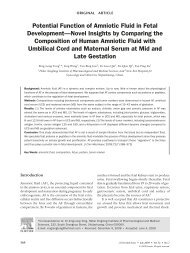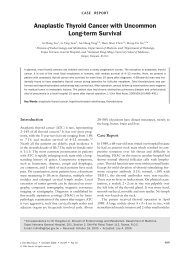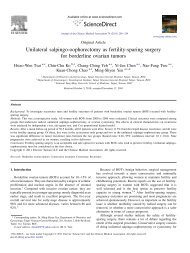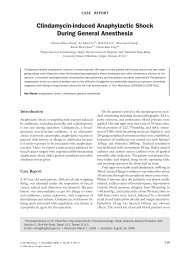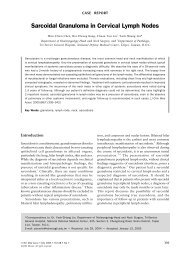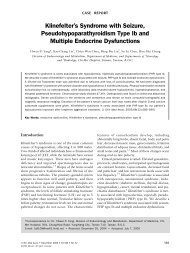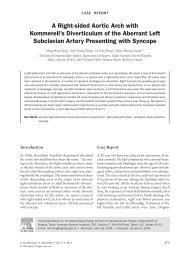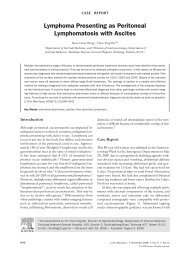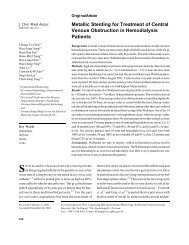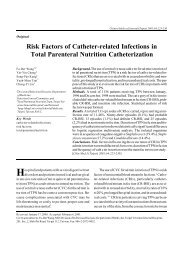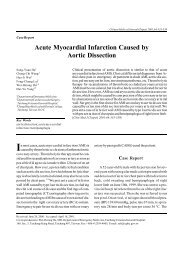Surgical Anatomy of Supratentorial Midline Lesions
Surgical Anatomy of Supratentorial Midline Lesions
Surgical Anatomy of Supratentorial Midline Lesions
Create successful ePaper yourself
Turn your PDF publications into a flip-book with our unique Google optimized e-Paper software.
Copyright © by the Congress <strong>of</strong> Neurological Surgeons Volume 47(2), August 2000, pp 417-427<br />
Fiber Dissection Technique: Lateral Aspect <strong>of</strong> the Brain<br />
[<strong>Surgical</strong> <strong>Anatomy</strong> and Technique]<br />
Türe, Ugur M.D.; Yasargil, M. Gazi M.D.; Friedman, Allan H. M.D.; Al-Mefty, Ossama M.D.<br />
Department <strong>of</strong> Neurosurgery (UT), Marmara University School <strong>of</strong> Medicine, Istanbul,<br />
Turkey; Department <strong>of</strong> Neurosurgery (UT, MGY, OA-M), University <strong>of</strong> Arkansas for Medical<br />
Sciences, Little Rock, Arkansas; and Department <strong>of</strong> Neurosurgery (AHF), Duke University<br />
School <strong>of</strong> Medicine, Durham, North Carolina<br />
Received, September 22, 1999.<br />
Accepted, March 29, 2000.<br />
Abstract<br />
OBJECTIVE: The fiber dissection technique involves peeling away the white matter tracts <strong>of</strong> the brain to display its three-dimensional<br />
anatomic organization. Early anatomists demonstrated many tracts and fasciculi <strong>of</strong> the brain using this technique. The complexities <strong>of</strong> the<br />
preparation <strong>of</strong> the brain and the execution <strong>of</strong> fiber dissection have led to the neglect <strong>of</strong> this method, particularly since the development <strong>of</strong> the<br />
microtome and histological techniques. Nevertheless, the fiber dissection technique is a very relevant and reliable method for neurosurgeons to<br />
study the details <strong>of</strong> brain anatomic features.<br />
METHODS: Twenty previously frozen, formalin-fixed human brains were dissected from the lateral surface to the medial surface, using the<br />
operating microscope. Each stage <strong>of</strong> the process is described. The primary dissection tools were handmade, thin, wooden spatulas with tips <strong>of</strong><br />
various sizes.<br />
RESULTS: We exposed and studied the myelinated fiber bundles <strong>of</strong> the brain and acquired a comprehensive understanding <strong>of</strong> their<br />
configurations and locations.<br />
CONCLUSION: The complex structures <strong>of</strong> the brain can be more clearly defined and understood when the fiber dissection technique is<br />
used. This knowledge can be incorporated into the preoperative planning process and applied to surgical strategies. Fiber dissection is<br />
time-consuming and complex, but it greatly adds to our knowledge <strong>of</strong> brain anatomic features and thus helps improve the quality <strong>of</strong><br />
microneurosurgery. Because other anatomic techniques fail to provide a true understanding <strong>of</strong> the complex internal structures <strong>of</strong> the brain, the<br />
reestablishment <strong>of</strong> fiber dissection <strong>of</strong> white matter as a standard study method is recommended. (47;427;2000)<br />
The segmental and compartmental occurrence <strong>of</strong> lesions within the central nervous system was emphasized by the senior author (MGY) in<br />
his publication Microneurosurgery (40–42). The importance <strong>of</strong> neuroanatomic laboratory training to learn in detail the cisternal, vascular, and<br />
gyral anatomic features and the construction <strong>of</strong> the white matter, which consists <strong>of</strong> six compartments and a complex connective fiber system,<br />
was stressed (42). A special freezing and dissection technique was developed by Joseph Klingler at the Institute <strong>of</strong> <strong>Anatomy</strong> in Basel,<br />
Switzerland, in the 1930s (Fig. 1) (19, 20, 23). This technique was learned by the senior author (MGY) in the 1950s (Fig. 2) (15). The<br />
knowledge gained from this technique was applied to all <strong>of</strong> his routine microneurosurgical procedures (40–42). The junior author (UT)<br />
developed a great interest in this field while visiting the Department <strong>of</strong> Neurosurgery, University Hospital, in Zürich, Switzerland, in the 1990s<br />
and has since revitalized the dissection technique for connective fibers (36, 37). The intention <strong>of</strong> this report is to stimulate the young generation<br />
<strong>of</strong> neurosurgeons to acquire pr<strong>of</strong>iciency in fiber dissection and to become experts in surgical neuroanatomic features.



